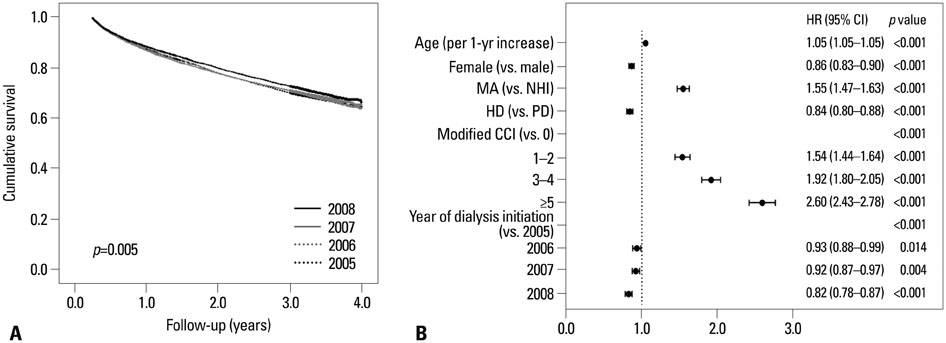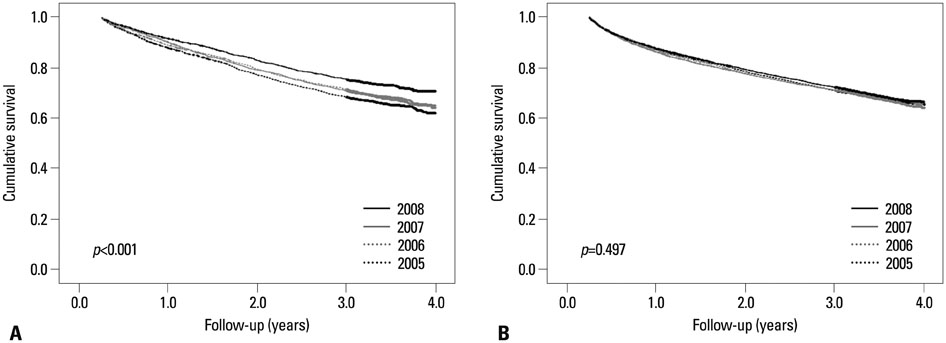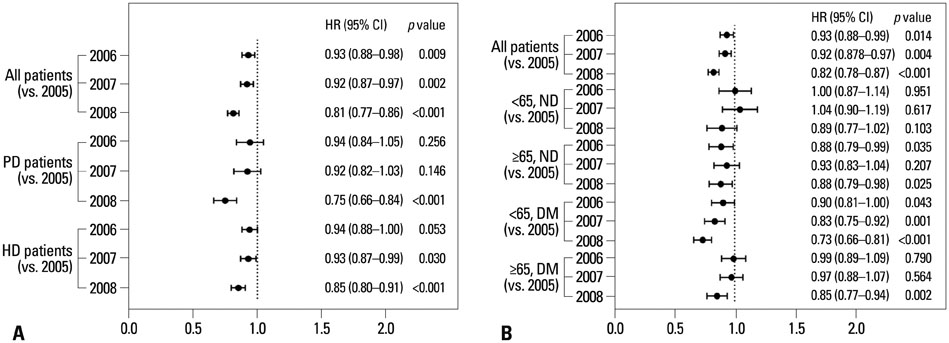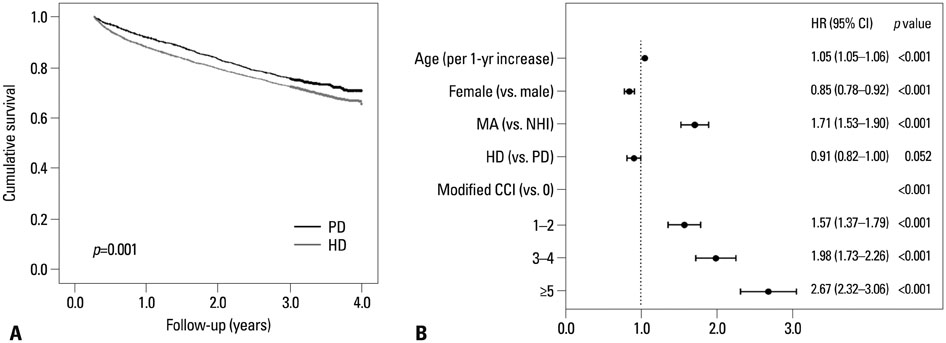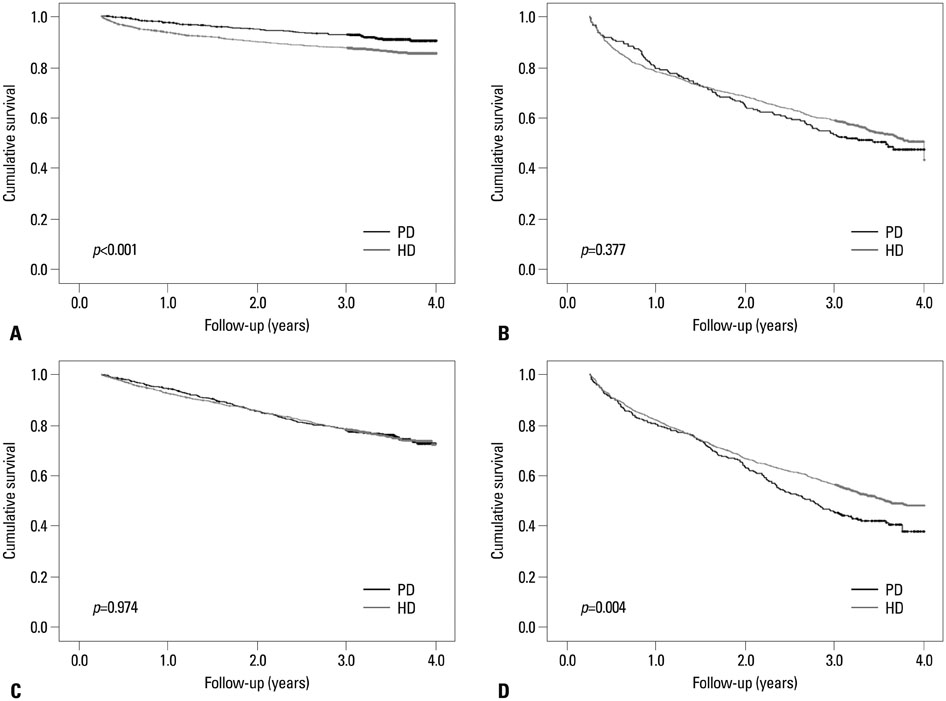Yonsei Med J.
2015 May;56(3):666-675. 10.3349/ymj.2015.56.3.666.
Improving Survival Rate of Korean Patients Initiating Dialysis
- Affiliations
-
- 1Department of Internal Medicine, School of Medicine, Ewha Womans University, Seoul, Korea. drryu@ewha.ac.kr
- 2Department of Internal Medicine, Wonkwang University College of Medicine, Sanbon Hospital, Gunpo, Korea.
- 3Department of Public Health, Graduate School, Korea University, Seoul, Korea.
- 4Ewha Medical Research Institute, School of Medicine, Ewha Womans University, Seoul, Korea.
- 5Department of Preventive Medicine, College of Medicine, Korea University, Seoul, Korea.
- KMID: 2450339
- DOI: http://doi.org/10.3349/ymj.2015.56.3.666
Abstract
- PURPOSE
The aim of this study was to investigate whether the survival rate among Korean dialysis patients changed during the period between 2005 and 2008 in Korea.
MATERIALS AND METHODS
A total of 32357 patients who began dialysis between January 1, 2005 and December 31, 2008 were eligible for analysis. Baseline demographics, comorbidities, and mortality data were obtained from the database of the Health Insurance Review & Assessment Service.
RESULTS
Kaplan-Meier curves according to the year of dialysis initiation showed that the survival rate was significantly different (log-rank test, p=0.005), most notably among peritoneal dialysis (PD) patients (p<0.001), although not among hemodialysis (HD) patients (p=0.497). In multivariate analysis, however, patients initiating either HD or PD in 2008 also had a significantly lower risk of mortality compared to those who began dialysis in 2005. Subgroup survival analysis among patients initiating dialysis in 2008 revealed that the survival rate of PD patients was significantly higher than that of HD patients (p=0.001), and the survival benefit of PD over HD remained in non-diabetic patients aged less than 65 years after adjustment of covariates.
CONCLUSION
Survival of Korean patients initiating dialysis from 2005 to 2008 has improved over time, particularly in PD patients. In addition, survival rates among patients initiating dialysis in 2008 were different according to patients' age and diabetes, thus we need to consider these factors when dialysis modality should be chosen.
Keyword
MeSH Terms
-
Adult
Aged
Comorbidity
Female
Humans
Kaplan-Meier Estimate
Kidney Failure, Chronic/*mortality/therapy
Male
Middle Aged
Multivariate Analysis
Peritoneal Dialysis/*statistics & numerical data
Registries
Renal Dialysis/*statistics & numerical data
Republic of Korea/epidemiology
Risk
Survival Analysis
Survival Rate/*trends
Treatment Outcome
Figure
Cited by 1 articles
-
Administration of a High-Dose Erythropoietin-Stimulating Agent in Hemodialysis Patients is Associated with Late Arteriovenous Fistula Failure
Hye Yun Jeong, Eun-Jung Ko, Sang Hoon Kim, Mi Jung Lee, Hye Jeong Cho, Dong Ho Yang, So-Young Lee
Yonsei Med J. 2017;58(4):793-799. doi: 10.3349/ymj.2017.58.4.793.
Reference
-
1. U.S. Renal Data System, USRDS 2012 Annual Data Report. Atlas of Chronic Kidney Disease and End-Stage Renal Disease in the United States. Bethesda, MD: National Institutes of Health, National Institute of Diabetes and Digestive and Kidney Diseases;2012.2. Murphy SW, Foley RN, Barrett BJ, Kent GM, Morgan J, Barré P, et al. Comparative mortality of hemodialysis and peritoneal dialysis in Canada. Kidney Int. 2000; 57:1720–1726.
Article3. Heaf JG, Wehberg S. Relative survival of peritoneal dialysis and haemodialysis patients: effect of cohort and mode of dialysis initiation. PLoS One. 2014; 9:e90119.
Article4. Huang CC, Cheng KF, Wu HD. Survival analysis: comparing peritoneal dialysis and hemodialysis in Taiwan. Perit Dial Int. 2008; 28:Suppl 3. S15–S20.
Article5. Lee CC, Sun CY, Wu MS. Long-term modality-related mortality analysis in incident dialysis patients. Perit Dial Int. 2009; 29:182–190.
Article6. Mehrotra R, Chiu YW, Kalantar-Zadeh K, Bargman J, Vonesh E. Similar outcomes with hemodialysis and peritoneal dialysis in patients with end-stage renal disease. Arch Intern Med. 2011; 171:110–118.
Article7. Quinn RR, Hux JE, Oliver MJ, Austin PC, Tonelli M, Laupacis A. Selection bias explains apparent differential mortality between dialysis modalities. J Am Soc Nephrol. 2011; 22:1534–1542.
Article8. Sanabria M, Muñoz J, Trillos C, Hernández G, Latorre C, Díaz CS, et al. Dialysis outcomes in Colombia (DOC) study: a comparison of patient survival on peritoneal dialysis vs hemodialysis in Colombia. Kidney Int Suppl. 2008; S165–S172.
Article9. van de Luijtgaarden MW, Noordzij M, Stel VS, Ravani P, Jarraya F, Collart F, et al. Effects of comorbid and demographic factors on dialysis modality choice and related patient survival in Europe. Nephrol Dial Transplant. 2011; 26:2940–2947.
Article10. Weinhandl ED, Foley RN, Gilbertson DT, Arneson TJ, Snyder JJ, Collins AJ. Propensity-matched mortality comparison of incident hemodialysis and peritoneal dialysis patients. J Am Soc Nephrol. 2010; 21:499–506.
Article11. Yeates K, Zhu N, Vonesh E, Trpeski L, Blake P, Fenton S. Hemodialysis and peritoneal dialysis are associated with similar outcomes for end-stage renal disease treatment in Canada. Nephrol Dial Transplant. 2012; 27:3568–3575.
Article12. Jaar BG, Coresh J, Plantinga LC, Fink NE, Klag MJ, Levey AS, et al. Comparing the risk for death with peritoneal dialysis and hemodialysis in a national cohort of patients with chronic kidney disease. Ann Intern Med. 2005; 143:174–183.
Article13. Termorshuizen F, Korevaar JC, Dekker FW, Van Manen JG, Boeschoten EW, Krediet RT, et al. Hemodialysis and peritoneal dialysis: comparison of adjusted mortality rates according to the duration of dialysis: analysis of The Netherlands Cooperative Study on the Adequacy of Dialysis 2. J Am Soc Nephrol. 2003; 14:2851–2860.
Article14. Liem YS, Wong JB, Hunink MG, de Charro FT, Winkelmayer WC. Comparison of hemodialysis and peritoneal dialysis survival in The Netherlands. Kidney Int. 2007; 71:153–158.
Article15. Korevaar JC, Feith GW, Dekker FW, van Manen JG, Boeschoten EW, Bossuyt PM, et al. Effect of starting with hemodialysis compared with peritoneal dialysis in patients new on dialysis treatment: a randomized controlled trial. Kidney Int. 2003; 64:2222–2228.
Article16. McDonald SP, Marshall MR, Johnson DW, Polkinghorne KR. Relationship between dialysis modality and mortality. J Am Soc Nephrol. 2009; 20:155–163.
Article17. Kim H, Kim KH, Park K, Kang SW, Yoo TH, Ahn SV, et al. A population-based approach indicates an overall higher patient mortality with peritoneal dialysis compared to hemodialysis in Korea. Kidney Int. 2014; 86:991–1000.
Article18. Charlson ME, Pompei P, Ales KL, MacKenzie CR. A new method of classifying prognostic comorbidity in longitudinal studies: development and validation. J Chronic Dis. 1987; 40:373–383.
Article19. Hemmelgarn BR, Manns BJ, Quan H, Ghali WA. Adapting the Charlson Comorbidity Index for use in patients with ESRD. Am J Kidney Dis. 2003; 42:125–132.
Article20. Quan H, Sundararajan V, Halfon P, Fong A, Burnand B, Luthi JC, et al. Coding algorithms for defining comorbidities in ICD-9-CM and ICD-10 administrative data. Med Care. 2005; 43:1130–1139.
Article21. Mortier S, Faict D, Schalkwijk CG, Lameire NH, De Vriese AS. Long-term exposure to new peritoneal dialysis solutions: effects on the peritoneal membrane. Kidney Int. 2004; 66:1257–1265.
Article22. Johnson DW, Brown FG, Clarke M, Boudville N, Elias TJ, Foo MW, et al. Effects of biocompatible versus standard fluid on peritoneal dialysis outcomes. J Am Soc Nephrol. 2012; 23:1097–1107.
Article23. Cho Y, Johnson DW, Craig JC, Strippoli GF, Badve SV, Wiggins KJ. Biocompatible dialysis fluids for peritoneal dialysis. Cochrane Database Syst Rev. 2014; 3:CD007554.
Article24. Collins AJ, Hao W, Xia H, Ebben JP, Everson SE, Constantini EG, et al. Mortality risks of peritoneal dialysis and hemodialysis. Am J Kidney Dis. 1999; 34:1065–1074.
Article25. Ganesh SK, Hulbert-Shearon T, Port FK, Eagle K, Stack AG. Mortality differences by dialysis modality among incident ESRD patients with and without coronary artery disease. J Am Soc Nephrol. 2003; 14:415–424.
Article26. Stack AG, Molony DA, Rahman NS, Dosekun A, Murthy B. Impact of dialysis modality on survival of new ESRD patients with congestive heart failure in the United States. Kidney Int. 2003; 64:1071–1079.
Article27. Vonesh EF, Snyder JJ, Foley RN, Collins AJ. The differential impact of risk factors on mortality in hemodialysis and peritoneal dialysis. Kidney Int. 2004; 66:2389–2401.
Article28. Schaubel DE, Morrison HI, Fenton SS. Comparing mortality rates on CAPD/CCPD and hemodialysis. The Canadian experience: fact or fiction? Perit Dial Int. 1998; 18:478–484.
Article29. Heaf JG, Løkkegaard H, Madsen M. Initial survival advantage of peritoneal dialysis relative to haemodialysis. Nephrol Dial Transplant. 2002; 17:112–117.
Article30. Vonesh EF, Snyder JJ, Foley RN, Collins AJ. Mortality studies comparing peritoneal dialysis and hemodialysis: what do they tell us? Kidney Int Suppl. 2006; S3–S11.
Article31. Held PJ, Brunner F, Odaka M, García JR, Port FK, Gaylin DS. Five-year survival for end-stage renal disease patients in the United States, Europe, and Japan, 1982 to 1987. Am J Kidney Dis. 1990; 15:451–457.
Article32. Yoshino M, Kuhlmann MK, Kotanko P, Greenwood RN, Pisoni RL, Port FK, et al. International differences in dialysis mortality reflect background general population atherosclerotic cardiovascular mortality. J Am Soc Nephrol. 2006; 17:3510–3519.
Article33. Jin DC, Ha IS, Kim NH, Lee SW, Lee JS, Yoon SR, et al. Brief report: Renal replacement therapy in Korea, 2010. Kidney Res Clin Pract. 2012; 31:62–71.
Article34. Marinovich S, Lavorato C, Rosa-Diez G, Bisigniano L, Fernández V, Hansen-Krogh D. The lack of income is associated with reduced survival in chronic haemodialysis. Nefrologia. 2012; 32:79–88.
- Full Text Links
- Actions
-
Cited
- CITED
-
- Close
- Share
- Similar articles
-
- Impact of Early Initiation of Dialysis on Clinical Outcome
- The Study on Survuval Rates and Causes of Death in ESPD Patients with Hemodialysis
- The Effect of Residual Renal Function at the Initiation of Dialysis on Patient Survival
- New dialysis treatment options for patients with end-stage chronic kidney disease
- Effect of Initiating Dialysis on Inflammatory State and Immune Response in Patients with End-stage Renal Disease

